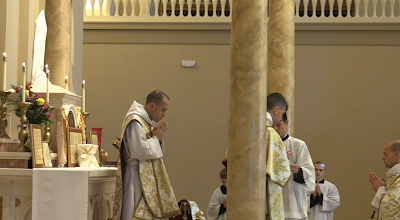In honor of
the Major Rogation, I've put together a list of prayers and blessings to be said by a priest or the father of the family. The exact ones to be said vary depending on a person's property and what features it has. Please share it with anyone who needs a copy.
Blessing of a Farm
(This prayer may be said to obtain God's blessing on a farm with its buildings or for the farmhouse alone.)
Bless, O Lord, Almighty God, this house (or this farm). May health and purity, goodness and meekness, and every virtue reign here. May all those who dwell here be filled with faithfulness to Thy law and with thanksgiving to God, the Father, the Son, and the Holy Spirit. May this blessing remain on this house (or this farm) and all who dwell here. Through Christ our Lord. Amen.
Blessing of All Domestic Animals
Lord God, King of heaven and earth, Thou the Word of the Father by whom all creatures were given us for our support; look down, we beseech Thee, on our lowliness. As Thou hast given us these animals to assist us in our labors and needs, so mayest Thou in thy great goodness and mercy bless them from above, guard and preserve them; and, while Thou givest thy servants temporal benefits, mayest Thou grant us Thy continual grace so that we may praise Thy holy name with thanksgiving. Amen.
Blessing of a Water Supply
O Lord, Almighty God, who hast given us an ample supply of water, led off by pipes from this source, grant that, by Thy assistance and blessing and our cooperation, every diabolical attack and confusion may be kept off and that this water supply may always be pure and uncontaminated. Through Christ our Lord. Amen.
Blessing of a Spring or Well
We cry without ceasing, O Lord, to Thy Fatherly goodness that Thou wouldst sanctify this fountain of water with Thy heavenly blessing and make it suitable for every use. Drive from it every influence of the devil so that whoever draws from it or drinks this water may enjoy good health and full vigor, and give praise and thanks to Thee, the Preserver and
Sanctifier of all things. Through Christ our Lord. Amen.
Blessing of Pasture, Meadows, and Fields
O God, through whom every good thing has its beginning, and through whom it is improved and increased; grant, we beseech Thee, to us who cry to Thee, that this work, which we are beginning for the praise of Thy name, may be happily brought to completion through the never failing gift of Thy fatherly wisdom. Through Christ our Lord. Amen.
Almighty, eternal God, Thou hast given to Thy priests a special grace so that we may be sure that whatever is worthily done by them in Thy name is done also by Thee. We beseech Thy clemency that Thou wouldst visit what we now visit, that Thou wouldst bless what we now bless, and that Thou wouldst stretch forth Thy mighty right arm over that which we now do, and that by the merits and intercession of Thy saints and this entrance of our humble persons, the demons may be put to flight and the angel of peace may enter in. Through Christ our Lord. Amen.
(This solemn blessing may be said by a priest some time before cattle are put on the pasture for summer. If the father of the family is offering this blessing, the second paragraph can be omitted.)
The Litany of the Saints is inserted here followed by:
Send forth Thy spirit and they shall be created; And Thou shalt renew the face of the earth. For the Lord will give goodness; and our earth shall yield her fruit.
We humbly beseech Thy clemency O Lord, that Thou wouldst render these fields (pastures, meadows) fertile with rains in due season, that Thou wousdst fill them with Thy blessing, and so grant that Thy people may be ever thankful for Thy gifts. Take infertility from the earth and fill the hungry with Thy gifts which the fruitful earth will yield in fullness that the poor and needy may raise the name of Thy glory, forever and ever. Amen.
The Solemn Exorcism of Harmful Animals
I conjure you mice (worms, sails, snakes, spiders, lice, ticks, etc.) in the name of God, the Almighty Father, of Jesus Christ, His only Son, and of the Holy Spirit who proceeds from both, that you go out from these fields and pastures and remain no more in them, but depart for places where you can harm no one. In the name of God, the Almighty, of the whole heavenly court, and of God's holy Church, I declare you accursed wherever you go so that you will become fewer day by day. May no part of you be found again, unless it be for man's welfare. May He graciously grant this, who will come to judge the living and the dead and the world by fire.
Note: Any prayer that is called an "exorcism" must be performed by a specially authorized priest. You could pray this prayer of course, but not perhaps to the same effect.
Blessing of Orchards and Vineyards
We beseech Thee, Almighty God, in Thy goodness, to pour down Thy blessings on these young shoots and sprouts which Thou wouldst grow into mature fruit. Grant to Thy people that they may always be permitted to grow, with due sunshine and rain, and make them gifts which the fruitful earth produces in fullness so that the poor and needy may praise Thy glory. Amen.
Sources:
1.
St. Mark's Day Blessings
2.
Catholic Culture
3.
Rogation & Ember Day Manual









































